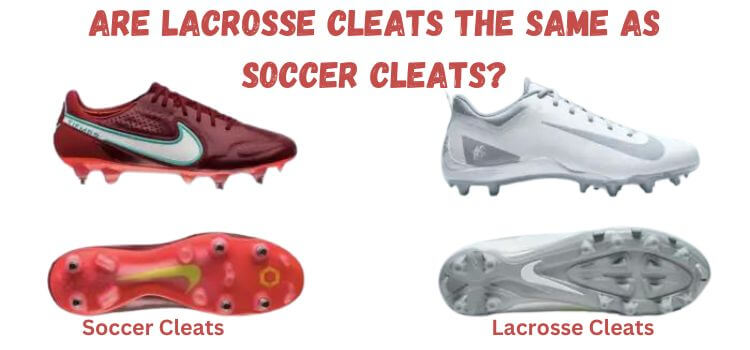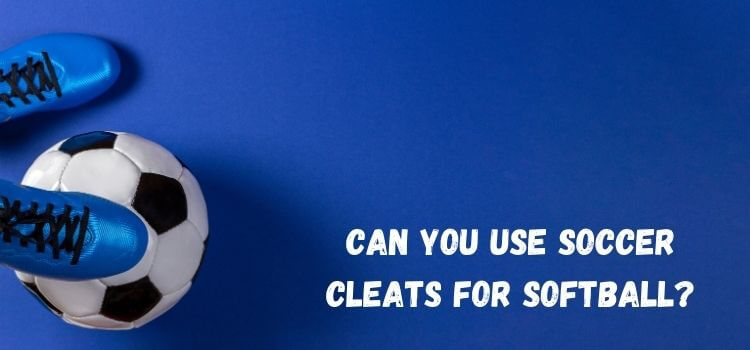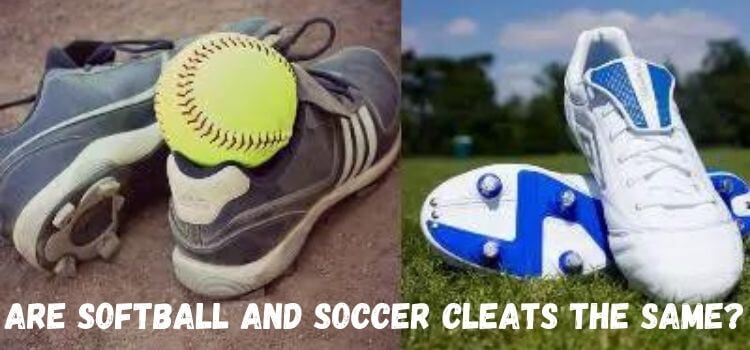As an Amazon Associate, I earn from qualifying purchases
Regarding sports, proper footwear is essential for optimal performance and safety. The type of cleats worn can make a significant difference for sports like lacrosse and soccer, where agility, speed, and traction are crucial. While lacrosse and soccer cleats may appear similar at first glance, notable differences cater to each sport’s unique demands.

Key Differences Between Lacrosse Cleats and Soccer Cleats
Design and Construction
Lacrosse cleats are designed with durability and stability in mind. They typically feature a higher cut to provide better ankle support and protection against twists and sprains. Additionally, lacrosse cleats may have reinforced toe areas to withstand the rigors of the game.
On the other hand, soccer cleats are designed for speed and agility. They are often lower-cut to allow for greater freedom of movement and agility on the field. Soccer cleats prioritize lightweight construction to enable quick acceleration and swift changes in direction.
Traction
Traction is vital in lacrosse and soccer, but the requirements differ slightly between the two sports. Lacrosse cleats typically have a combination of bladed and conical studs to provide stability on various surfaces, including grass and turf.
The multidirectional traction pattern lets players make quick cuts and maneuvers without losing grip.
In contrast, soccer cleats feature a variety of stud configurations tailored to different playing conditions. Firm-ground (FG) cleats have bladed or conical studs designed for natural grass surfaces, while soft-ground (SG) cleats have longer, metal-tipped studs for wet or muddy conditions.
Additionally, turf (TF) and indoor (IN) cleats have shorter rubber studs for artificial turf and indoor surfaces, respectively.
Materials Used
Both lacrosse and soccer cleats utilize lightweight and durable materials to enhance performance and durability. However, the materials may vary based on the manufacturer and intended use. Common materials used in cleat construction include synthetic leather, mesh, and rubber.
Special Features of Lacrosse Cleats
Ankle Support
Lacrosse cleats often feature a higher cut to provide additional ankle support and stability. This design helps reduce the risk of ankle injuries, which are common in lacrosse due to the game’s physical nature.
Toe Protection
Given the aggressive nature of lacrosse, cleats may include reinforced toe areas to protect against impacts from sticks, balls, or other players. This added protection helps prevent injuries and prolongs the lifespan of the cleats.
Special Features of Soccer Cleats
Lightweight Design
Soccer cleats prioritize lightweight construction to minimize fatigue and maximize speed on the field. The lightweight materials allow players to move quickly and efficiently without feeling weighed down by their footwear.
Stud Configuration
Soccer cleats come in various stud configurations to cater to different playing surfaces and conditions. Whether it’s firm ground, soft ground, turf, or indoor surfaces, there’s a cleat designed to provide optimal traction and stability.
Choosing the Right Cleats for Your Sport
When selecting cleats for lacrosse or soccer, it’s essential to consider factors such as playing surface, position, and personal preferences. Trying on different styles and brands can help determine the best fit and feel for your feet.
Importance of Proper Footwear in Sports Performance
The proper footwear can significantly impact performance and reduce the risk of injuries in sports. Investing in quality cleats specifically designed for your sport can enhance your agility, speed, and overall comfort on the field.
Tips for Maintaining Cleats
The best way to ensure your cleats last long and perform optimally is to maintain them properly. This includes cleaning them after each use, storing them in a cool, dry place, and inspecting them regularly for any signs of wear or damage.
Conclusion
While lacrosse and soccer cleats share some similarities, such as traction and durability, they are designed with distinct features to meet the specific demands of each sport. Understanding the differences can help athletes make informed decisions when selecting footwear for their chosen activity.
Frequently Asked Questions (FAQs)
While it’s technically possible, it’s not recommended. The design and stud configurations of lacrosse and soccer cleats are optimized for their respective sports, so using them interchangeably may compromise performance and increase the risk of injury.
Professional athletes often rely on specialized cleats tailored to their sport and playing style. These cleats are designed to provide optimal performance and support at the highest level of competition.
While some cleats may claim to be versatile enough for multiple sports, using cleats specifically designed for your chosen activity is generally recommended. This ensures proper fit, traction, and support tailored to the demands of the sport.
The lifespan of cleats can vary depending on factors such as frequency of use, playing surface, and maintenance. As a general rule of thumb, it’s recommended to replace cleats once they show significant signs of wear or no longer provide adequate support and traction.
Many manufacturers offer customization options for cleats, allowing athletes to personalize their footwear with custom colors, designs, and features. However, it’s essential to ensure that any modifications do not compromise the structural integrity or performance of the cleats.
Read Our More Articles
- How to Shrink Soccer Cleats for Maximum Comfort
- What Soccer Cleats Are Good for Wide Feet? The Ultimate Guide
- Can You Use Soccer Cleats for Lacrosse? A Comprehensive Guide
As an Amazon Associate, I earn from qualifying purchases


